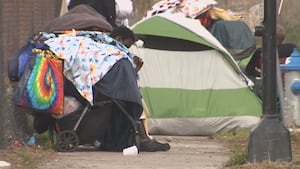New data from the Homeless Services Network shows Central Florida’s homeless population increased again this year, but it was a much smaller margin than previous years.
In all, 2,781 people were found sleeping in their cars, on the street, or in shelters on a single night in January as part an annual Point-in-Time Count, a census that takes place in communities across the country.
This year, the report, released by the Homeless Services Network of Central Florida, documented only a slight rise in overall homelessness for Orange, Osceola, and Seminole counties, but the nonprofit partially attributed that to fear spawned by a new state law that makes it illegal for local governments to allow public camping.
“We are grateful that this is the smallest percent increase in several years,” said Martha Are, the Homeless Services Network’s CEO. “However, we also experienced more difficulty in locating people this year, and increased reluctance to engage with staff and volunteers who were participating in the count process. People are hiding.”
The count found the total number of people experiencing homelessness on Jan. 27 had increased by only five since 2024.
Orange County’s total of 1,972 people experiencing homelessness had dropped by 2.1 percent. Seminole County’s 436 total was a 3.8 percent increase over 2024, and Osceola County’s 373 total was up by 8.7 percent over last year.
The number of people experiencing unsheltered homelessness dropped by four people since 2024.
In previous years, this population had been rising steeply, and the 2025 total was still 156% higher than 2022.
Are, said the data continues to reiterate the need for more shelter beds in the community, after plans for a controversial Sodo shelter were dropped by the city of Orlando in March.
“We know that we need at least 1,090 beds. And we know, that that’s probably an undercount,” said Are.
Channel 9 reached out to the City of Orlando on Friday, for an update on their shelter efforts.
“While we are not currently pursuing a standalone, brick and mortar building, the City of Orlando is committed to addressing homelessness and continues to work to create lasting solutions. Tackling this complex challenge requires regional collaboration and bold strategies, and the city remains dedicated to improving the lives of our most vulnerable residents,” said a City of Orlando Spokesperson.
According to Are, this year, non-profits across the region helped move 5,000 people experiencing homelessness off the streets and into housing.
She also noted there was a 29% drop in young adults, ages 18 to 24, who were sleeping on the streets or in the woods.
Are credited the decrease to renewed focus on homeless youth. She specifically highlighted an $8.4 million investment by the U.S. Department of Housing and Urban Development, into the Brighter Days Initiative, which connects young adults experiencing homelessness to caseworkers, job training, host home and rental assistance.
“What we’re seeing as effective with both the Brighter Days Initiative with our youth and with the other populations, is that housing focused strategies make a difference,” said Are.
A press conference held Friday also revealed new data from local school districts which showed a troubling number of students experiencing homelessness.
The districts overall homelessness counts include children whose families live in hotel rooms or are doubled up with relatives and other families — but this year the districts reported a rising number living in cars, parks, campgrounds, abandoned buildings or other places labeled as “inadequate housing.”
-
As of April 2, Orange County had 574 unsheltered/inadequately housed students (8,167 total homeless students)
-
As of Feb. 7*, Seminole County had 358 unsheltered/inadequately housed students (3,175 total homeless students)
-
As of April 4, Osceola had 127 unsheltered/inadequately housed students (3,281 total homeless students)
Christine Cleveland, a senior administrator for Orange County Public Schools, said the vast majority of those families have at least one working parent.
Cleveland said OCPS offers free meals to students and has a team focused on serving homeless students and families.
“We are the eighth largest district in the nation, and we really reflect that diversity. But in that we have this hidden struggle that is happening with our homeless population,” said Cleveland.
On Friday, Orange County Mayor Jerry Demings sent the following statement in response to the Point In Time count to Channel 9.
“I am encouraged to learn that the recent point-in-time count shows a slight decrease in Orange County’s homeless population, but I remain deeply concerned for those who are still unsheltered. Orange County Government continues to be the largest single funder of public services for the homeless in Central Florida.
In our 2024-2025 budget, we have dedicated over $56 million to support the needs of the homeless population, including mental health, health care services, and housing. Our goal is to work hand in hand with our regional partners to reduce the number of individuals experiencing homelessness and provide support to those most at risk.”
Meanwhile the Homeless Services Network shared the links below and asked for the public’s help:
https://www.yes2shelterandhousing.com/ — sign up to support additional affordable housing and shelters
https://www.ocps.net/departments/homeless_education — support homeless students in Orange County
https://www.foundationscps.org/donate/ — support homeless students in Seminole County
https://www.osceolaschools.net/Page/10861 — support homeless students in Osceola County
https://www.hsncfl.org/ — support the Homeless Services Network
https://www.serviceandlovetogether.org/ — support SALT Outreach
Click here to download our free news, weather and smart TV apps. And click here to stream Channel 9 Eyewitness News live.
Read the full article here
